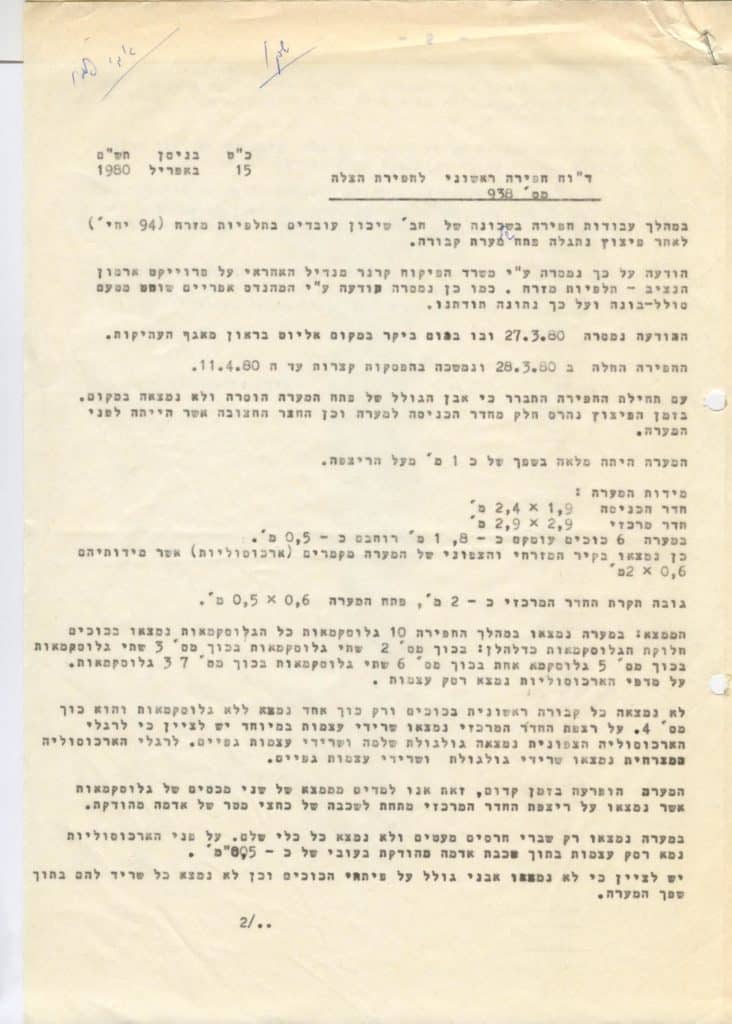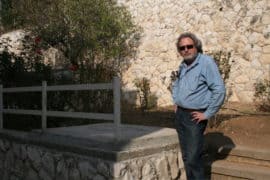The east Talpiot tomb, exposed to view by demolition by the the Solel Boneh construction crew, was reported by engineer A. Shochat to the Israel Department of Antiquities on March 27, 1980. That was a Thursday. Neighbors, including local children, visited the tomb that afternoon and also called the Department of Antiquities to report its discovery.

Eliot Braun, representing the IDA, made an initial inspection and reported to Amos Kloner, who visited the site, and wrote up a preliminary hand written memo to Department of Antiquities director Abi Eitan dated Friday, March 28, 1980. He requested a rescue excavation permit with Yosef Gath as director of excavations. Kloner included in his memo a preliminary sketch of the tomb with its outer courtyard, its entrance with the interesting facade, and the inner chamber with six kokhim, and two archosolia, or primary burial shelves, on the north and west walls. With the Sabbath approaching the tomb was left open until Sunday morning. The permit for a rescue excavation was officially issued on Monday, March 31st, by Eitan, and registered as license # 938. Kloner recalls that the ossuaries were removed from the tomb on Friday morning, before the Sabbath, but neighbors and others involved, including Shimon Gibson, recalled seeing the ossuaries outside the tomb, ready for transport to the Rockefeller Museum, on Sunday morning. Given the substantial amount of soil covering the ossuaries it seems likely they were dug out on Friday but not actually removed and transported until Sunday.
Gath, along with Shimon Gibson, who was invited by Kloner to serve as the surveyor, showed up Sunday morning to begin their work with the assistance of 3-4 workers. In his director’s report, filed on April 15, 1980, Gath notes April 11th as the official “end” of the excavation and records that work proceeded “intermittently” over that period, which of course, included, the eight days of Passover. Monday, the second day of the excavation, was Nisan 14 on the Jewish calendar, Erev Pesach, the night of the Seder, so much of the work was done on Sunday and Monday morning, including the removal of 10 ossuaries, the removal of a .5m of soil that had filled the central chamber, the tagging and registration of the artifacts, and sending them to the Israel Department of Antiquities as it was then called.
Gibson carefully recorded on his official sketch the location of the ossuaries in the various kokhim, which were numbered 2-7. Kokhim 2, 3, and 6 had two ossuaries, kok 5 had one, kok 7 had three, and kok 4 had none. On the original floor, under the fill, in front of each of the archosolium, was a human skull with remnants of arm and leg bones, both noted in Gath’s April 15th report. Gibson also includes in his sketch a third skull in the southeast corner of the central chamber, not specifically mentioned by Gath. A few ceramic pottery sherds were found that were dated Early Roman. There were no primary burials in the kokim and on the surface of the arcosolia were crushed bones packed in a few centimeters of soil. No covers were found for the kokhim, there was no golal, or blocking stone for the entrance to the tomb found, two broken ossuary lids were found on the floor under the fill–all indicating, according to Gath, that the tomb had been disturbed in ancient times.
Bones: Kloner remembers that the bones from the floor of the tomb were eventually turned over to the Jewish religious authorities but it is not clear whether any or all of them were first examined by an anthropologist. Joe Zias has checked his own personal records and says they were not given to him. There is no anthropological report in the IAA files. Kloner also notes that the bones in the ossuaries were in an advanced state of deterioration. As far as the number of individuals in the tomb Kloner makes clear in both his article (footnote #2), and in his interview, that his numbers as based on demographic averages or estimates, taken from tombs of this type, not any precise anthropological inventory of the bones actually found in this particular tomb. He calculates 1.7 individuals per ossuary (thus 17 individuals), plus an average of the same number outside (18) for a total of 35 as a total estimate.
Inscriptions: It is apparently not the case, as some have imagined, that the inscriptions on the six ossuaries were read instantly in the field by Gath or others. In Gath’s official excavation report, filed on April 15, 1980, four days after the excavation was officially completed, he notes that “up to this point four ossuaries appear to be inscribed,” indicating that two of the six inscribed were not yet so identified. He says nothing about the names themselves. Gibson does not recall any discussion of the inscriptions or the names in the field. This is further confirmed by line in Gath’s preliminary report published some time after the excavation was completed: “Some inscriptions in Greek and Aramaic were found in the cave that have not been deciphered yet.” According to Kloner the deciphering and translation of all six inscriptions was done subsequently by L. Rahmani sometime after they arrived at the Rockefeller and could be properly cleaned and studied. Just when this took place I do not know.
Kloner is also of the view that ossuary 80.509, the 10th, which was uninscribed and plain, was put in the courtyard of the Rockefeller for reasons of lack of space and like many other nondescript ossuaries was not included in Rahmani’s catalogue. I am not sure if he knows this independently or is basing it on Joe Zias’s claim that he now remembers putting that ossuary out there. Kloner is quite sure it can not be the so-called James ossuary, the inscription of which he judges to be forged (I am not sure if he thinks in whole or in part), because, although the height and width measurements match, the the upper length of the two is off by 4 centimeters based on his information (60cm vs. 56cm). He is also certain that all 10 were delivered to the Rockefeller for photographing and examination.
I remain completely open to any and all evidence on the so-called “missing ossuary,” (a term first used by the IAA not by me). In my book The Jesus Dynasty, I focused on what evidence exists regarding the provenance of the James ossuary, the inscription of which I believe to be authentic (“James son of Joseph, brother of Jesus”). I discuss what Oded Golan told Rafi Lewis in a private conversation that would seem to indicate that the James ossuary came from a tomb in Akeldama, perhaps as recently as 2001 or a bit earlier, according to the government indictment of Golan. I also discuss the east Talpiot tomb with its interesting cluster of names, including “Jesus son of Joseph,” and whether the James ossuary might possibly be the missing 10th since there is no photo or description of it surviving other than the one word “plain.” I also note that the dimensions of the James ossuary, as recently remeasured by the IAA, match up so closely. Also, Golan insists he had had the ossuary for decades, which puts one back at least to 1980 or earlier, but in his first interviews he was not precise about the date. The stamp on the photo that has now been admitted into evidence in his trial, “Expiry 76,” apparently indicates the expiration date of the paper upon which the photo is printed. I should clarify that in raising the question about the James ossuary being the missing 10th of Talpiot I have never implied there was any kind of fraud or smuggling on the part of any of the officials involved, or that anything was improperly handled.
Only recently, with the preliminary patina tests done on the James ossuary and the Jesus son of Joseph ossuary from Talpiot, is there new evidence that the James ossuary might have indeed come from the Talpiot tomb. Shimon Gibson has never been convinced of the 10th missing ossuary option, but he has raised another possibility, that the James ossuary might be a missing 11th ossuary, removed from the tomb prior to the inventory of the official 10, particularly if the patina tests are indicative of its provenance. There are several questions in this regard that are unresolved. Was the entrance to the tomb accessible even before the blast on March 27th exposed it to full view by blowing open the porch and its roof? The absence of a blocking stone might indicate such. Or alternatively, if the tomb was left open and exposed on the Sabbath between its discovery and the excavation that began on Sunday morning, who knows who might have entered it? Neighbors report children playing with the bones and a general local stir over the exposure of the tomb itself for the first two days.
Krumbein’s tests have indicated that the James ossuary shows erosion and plant growth along the bottom as if it were exposed to outside elements at some point in its history, either in ancient or modern times. His initial estimate of a period of 200 years he has recently said was not precise, and the period of such exposure could be much shorter. The oddly faint pattern on one side of the James ossuary, along with its faded color makes one wonder whether it might have had a complex history even in ancient times. It does not have the “like new” look of most ossuaries that are sealed in a single tomb undisturbed for 2000 years. What is needed is a further refinement of the patina comparisons with a wider sample of ossuaries from more tombs in the area, plus any other types of comparative tests between the James ossuary and the nine we have from the east Talpiot tomb.
++++++++++++++++
So what is “new” in this post? I have put in a lot of detail that might not be generally available but the points and issues that stand out for me are the following:
- When Gath wrote his final report on April 15, 1980 only four of the ossuaries had been recognized as inscribed
- Kloner’s estimates of the individuals buried in the tomb are not counts but demographic estimates
- The tomb was open and exposed from March 27 to March 30th
- It would be helpful to know which ossuaries were grouped in which kokhim and perhaps Kloner has notes on that
- When were the ossuaries measured and tagged? In the field or later at the Rockefeller? Are there forms and records?
- Are there photos of the inside of the tomb, of the ossuaries themselves at the dig site, or any of the excavation itself?









Comments are closed.